Marcus P. Corrosion mechanisms in theory and practice
Подождите немного. Документ загружается.

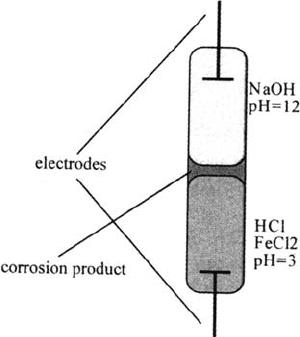
contaminating ions. The importance of the contaminating ions for the delamination
process is also known from literature in which the influence of cations of different
sizes is described. It proved that the size (and therefore the diffusion coefficient) of
the cations has a relation to the delamination rate [15,60–62].
Further proof of the existence of a membrane-like structure can be obtained
through simple model experiments: it proved to be possible to produce a similar
film in a test tube [63]. When such a tube is filled halfway with an NaOH solution
of pH 12, an HCl solution of pH 3 containing Fe
2+
ions can be injected underneath
(the density of the acid is higher). When this is done, a film of Fe(OH)
2
-like products
is formed instantly and the geometry shown in Figure 11 is created.
This situation is stable for several weeks. Depending on the disturbance during
the injection of the acid, the film can be thick (several millimeters) and colorful or
very thin (hardly visible) and pale white. If the iron ions are omitted from the acid
solution, the situation can also be created, but after 10 min the two solutions have
completely mixed. So this Fe-containing film indeed has a stabilizing effect as
was predicted from the observations on small blisters.
Further proof of the existence of the stabilizing film was also found in other
tests: it was also possible to create it in a neutral NaCl solution by electrochemical
dissolution of the central electrode in Figure 12. In this experiment a disk of carbon
steel was placed in a sheet of carbon steel. The whole panel was embedded in
epoxy and on the surface a container was glued. A 3% sodium chloride solution
was put in the container and the central electrode was connected to a potentiostat
and was made the anode, the rest of the panel being the cathode. One volt was
applied, causing rapid dissolution of the disk (Fe to Fe
2+
). On the cathode hydrogen
gas was formed (and maybe also oxygen consumed). In that case the pH is increased
at the outer ring, resulting in the formation of the sphere of corrosion products.
Anodic Undermining
The model for anodic undermining shows large similarities to cathodic delamination.
The main difference is the fact that oxygen transport through an open defect or
704 de Wit et al.
Figure 11 Schematic picture of the situation in a test tube.
Copyright © 2002 Marcel Dekker, Inc.
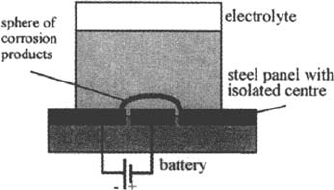
porous corrosion products is faster than through the coating. As a result of this, the
location of cathodic and anodic sites underneath the deadhering coating is
reversed. Delamination now proceeds through dissolution of the interface between
coating and metal in the acidic anolyte. In some cases also the osmotic pressure
that is caused by the formation of voluminous solid corrosion products may help
the delamination process by “lifting” the coating.
Anodic undermining is mainly reported on aluminum, which forms only Al
3+
ions and porous corrosion products. Especially in the presence of chlorides, the
natural oxide is easily attacked. Similarly to cathodic delamination, in this case
also the anions and cations are separated leading to the formation of an HCl solution
at the delamination front.
Filiform Corrosion
A specific type of delamination that is also driven by a differential aeration cell is
filiform corrosion [5,6,62,63]. In most cases it is related to anodic undermining,
especially because it occurs mainly on aluminum alloys. Filiform corrosion is a
specific type of delamination that occurs only under atmospheric condition with
relative humidity between approximately 50 and 90%. Small threadlike delamination
tracks are formed that in general follow irregularities on the surface (either rolling
or grinding marks). New interest in this special form of corrosion was stimulated
by many practical cases along the coastal areas in Europe. It may be expected that
new mechanistic information will become available within the next 2 years.
Flash and Early Rust
Two special types of corrosion failure that occur exclusively with water-based
coatings are flash and early rust. Both look similar and are often treated similarly
in the literature. They are, however, caused by different mechanisms and although
they occur under similar circumstances they should be treated differently.
Early Rusting
A measles-like rusty appearance may occur when a cold steel substrate is pained
under high-moisture conditions with a latex paint [6,50,62] immediately when the
coating is touch dry. This is called early rusting. This corrosion form occurs only
when the following conditions are met:
Organic Coatings 705
Figure 12 Production of the artificial sphere of corrosion products; 3% sodium chloride
is poured into a container that is glued on the surface.
Copyright © 2002 Marcel Dekker, Inc.
A thin (up to 40 μm) latex coating has been applied.
The substrate temperature is low.
The air humidity is high.
Early rusting is a result of the special curing mechanism of latex coatings.
Water evaporates from the coating, while dispersed latex particles coalesce.
Capillary forces and surface tension deform the particles and diffusion of the polymer
chains among latex particles finally results in film hardening. It occurs under
conditions in which water-soluble iron salts diffuse through the coating to the
outer surface before the coating is completely hardened, which explains the
conditions given before. After final evaporation of the moisture at the outer surface,
the typical measles-like corrosion spots become visible.
To prevent early rust, inhibitors are often added to the paint formulation.
Flash Rusting
The appearance of brown rust stains on a blasted steel surface immediately after
applying a water-based primer is called flash rusting [62]. The cause of this type
of corrosion is the remaining contaminants after the blast cleaning. The grit on the
surface provides crevices or local galvanic cells that activate the corrosion process
as soon as the water-based primer wets the surface. This type of corrosion generally
also occurs when coatings have remained wet for longer times due to lower
temperature, high relative humidity, or extreme thickness of the layer.
Although inhibitors might provide a certain degree of protection, the most
logical choice to prevent this type of corrosion is to prevent the presence of
contaminants on the surface.
SPECIALTIES
Coatings for Marine Applications
Seawater and the atmosphere above seawater are extremely corrosive environments.
Organic coatings are widely used to protect steel constructions in these cases, so
the choice and buildup of the coating system are often illustrative of the possibilities
of protection by organic coatings [64].
Protection of the underwater part of a ship’s hull or offshore construction
requires corrosion inhibition, water resistance, antifouling properties, and
compatibility with cathodic protection. Cathodic protection is used to protect the steel
in case the coating is damaged.
The corrosion inhibition and water resistance are obtained by paint systems
formed by several anticorrosive coats based on epoxy, vinyl, chlorinated rubber, or
bituminous coatings.
Coal-tar epoxy systems and vinyl tar coating have been used rather
successfully from a technical point of view, but their use is now forbidden in some
industrialized countries because of their effect on human health. In their place,
high solid tar-free epoxy and glass flake–reinforced epoxies are used.
Aluminum flakes are usually added to bituminous coatings, but these flakes
have also been added to epoxy systems to act as active anticorrosive agents [9].
Normally, the buildup of a protective system is as follows:
706 de Wit et al.
Copyright © 2002 Marcel Dekker, Inc.
Primer (indication 50 μm)
One or two layers of anticorrosive coating (indication 250 to 400 μm)
Tiecoat/sealer (indication 75 μm) to serve as intermediate between anticorrosive
system and antifouling (for example, to improve adherence or to prevent
bleeding of the tar)
Antifouling (indication 200 μm)
Coatings for Fouling Prevention
Some attention is given to a particular group of organic coatings, intended for the
protection of ships and marine structures against plant and animal growth: the
antifoulings.
In the sea and in estuaries, fouling chiefly consists of microorganisms, algae,
barnacles, shellfish, tube worms, etc. Fouling develops most rapidly on stationary
and slow-moving vessels (speed < 4 knots).
The disadvantages of fouling for vessels are evident in higher fuel consumption,
reduction of maximum speed and maneuverability, corrosion, mechanical damage,
and high maintenance costs [65]. Even with a limited amount of fouling (~ 1% of
the underwater surface of the vessel), the friction is increased to such an extent
that significantly more fuel must be consumed in order to maintain the same sailing
speed. This can lead to substantial financial loss, depending upon fuel prices; e.g.,
during the 1970s oil crisis, a loss of $300,000 per ship, per year, was not uncommon
[66,67]. Fouling on ships between 1850 and 35,000 tons causes an increase of
35–50% in fuel consumption after 6 months in temperate waters [68]. Even a thin
biofilm results in higher resistance and thereby a fuel loss of up to 20% [69–71].
Fouling on seagoing vessels and pleasure craft is mostly treated by paints from
which toxic components with an antifouling action are encouraged to leach [67–75].
The active ingredients are freed at the coating-water interface and any organisms
that try to stick to the hull are killed.
Organotin-Based Antifoulings
Organotin-based antifouling have been technically the most successful product for
years. They owe this success to a unique mechanism to prevent fouling. They
combine the toxic properties of TBT (tributyltin) with a controlled-release
mechanism, which guarantee constant activity up to 5 years (coating thickness is
the limitation).
A controlled and slow chemical reaction with the seawater at the paint surface
occurs and guarantees a constant but very low TBT release: The TBT binder, a
copolymer of tributyltin methacrylate and methyl methacrylate, hydrolyzes in
seawater at a constant linear rate. The binder becomes water soluble as soon as
enough TBT has been hydrolyzed. Seawater flowing against the ship’s hull polishes
off the hydrolyzed remainder of the binder.
The major disadvantage of TBT and other biocide-containing antifouling
coatings is the environmental problems that they cause [72], which have resulted
in legal restrictions on their use. For vessels under 25 m in length TBT has already
been prohibited in many countries, and a complete ban starting from 2003 is in
preparation by the International Maritime Organisation.
Organic Coatings 707
Copyright © 2002 Marcel Dekker, Inc.
Consequently, a great deal of research is going on all over the world. However,
so far alternatives technically and economically comparable to the TBT-based
systems have not been developed. The best new systems, based on copper acrylate
with some erodable properties, have a lifetime of only 3 years. Moreover, they
contain a large amount of copper with addition of “antifouling” compounds from
agriculture. In any case, it is clear that the environmental problem is not solved with
these new systems.
However, some useful methods for certain classes of ships have now become
available. These methods can serve in the future as an alternative to toxic paints
for all ships, “can serve” because a gulf exists between scientific developments
and practical use for shipping. Ship owners are understandably wary of completely
new and untried products and will make the change only when the risk is minimal.
This is, for example, currently the case with nonstick coatings.
Nonstick Coatings
Nonstick coatings, mostly based on silicon polymers, have, where fouling organisms
are concerned, an unattractively low surface energy [66,76–80]. The free surface
energy of the material determines whether an organism attaches or not. Only limited
prevention of fouling is provided, but the adhesion between the fouling and the
coating is weak; therefore, fouling can easily be removed or will fall off while
sailing if the speed is high enough (5–10 knots). In theory, the lifetime is unlimited
except when substances are used that have an additional antifouling effect through
leaching, e.g., “sweating” silicon oil or paraffin.
Systems were introduced on the market and presented as wonder products with
promised effective long-lasting protection, enduring for decades. However, reports
about the effectiveness of nonstick coatings became very contradictory. The mate-
rials often showed insufficient antifouling properties, but fouling was easily removed.
Weakness of the coatings and difficulties with their application are often reported.
The best results were achieved with polysiloxanes (silicon elastomers). In recent
years, with the exception of small improvements in mechanical strength and adhe-
sion to subsurfaces, no decisive developments have occurred and attention is now
focused on practical efficiency. Even though the antifouling effect is obviously im-
proved, some major obstacles are difficult to overcome: price (estimates vary: 5–100
times higher than the classic antifouling paints), difficult application (special appa-
ratus is needed; normal appliances are not suitable), mechanical frailty (with, as a
result, damaged areas where fouling quickly occurs), bad adhesion, and the necessity
to remove fouling if sailing is insufficient.
Pollution when using nonstick coatings is low in comparison with that of
systems based on biocide leaching, but emissions as a result of damage, pieces of
the coating chipping off, and possible leaching of coating ingredients must be
taken into account. Rapidly biodegradable silicon products could possibly minimize
pollution.
There are no products freely available on the market as yet. Practical application
has been effected in other areas (especially cooling water systems). Recent or current
sea trials with ships—e.g., in the United States, Australia, and France—confirm the
potential suitability, but because of the previously mentioned obstacles, the step to
commercial use will take several years at least, especially for larger vessels.
708 de Wit et al.
Copyright © 2002 Marcel Dekker, Inc.
MEASURING AND MONITORING METHODS
Introduction
An abundance of measuring techniques for characterizing or monitoring the
performance or organic coatings is available. In the last few years, several “new”
techniques were introduced to study the behavior of organic coatings at an almost
microscopic level. The standard techniques include electrical or electrochemical
techniques such as electrochemical impedance spectroscopy (EIS), dielectric
measurements, corrosion potential measurements, or polarization resistance
measurement. The new, local techniques are in general called “scanning probes”
and include the Kelvin probe, scanning vibrating electrode (SVET), scanning
reference electrode (SRET), and local EIS. Various techniques for developing a
detailed understanding of the polymer properties, including FTIR, DSC, DMTA,
TG, hardness measurements, and AFM, are also frequently used, and naturally also
test methods for dry and wet adhesion are important tools [7,9]. It is important to
combine the results of these various techniques in order to compose suitable models
for the different chemical and physical phenomena in these very complex systems.
In most cases, a specific method measures only one specific parameter of the coated
system that has no direct relation to the subject of interest. The water diffusion
coefficient (D), for instance, can easily be estimated with EIS [81]. The direct
relation of D to underfilm corrosion, however, is questionable. Therefore the
selection of a set of measuring techniques depends very much on the specific aim
of the investigator, who may be interested in a variety of phenomena such as water
uptake, curing, and underfilm corrosion that have a relation in a complete, complex
systems. These techniques, with their specific possibilities and limitations for
research and monitoring of organic coatings, could well be the subject of a complete
monograph. Within the framework of this chapter, a limited choice had to be made.
Because impedance measurements in the form of dielectric sensors, also in
situ, can in principle give a rather extensive package of information on all charge-
and dielectric-related phenomena including charge transfer reactions, diffusion
processes, and delamination, these will be described first. A second reason for this
choice is the possibility offered by this technique to arrive at lifetime predictions
based on short-term measurements [81–86]. After relatively short exposure times,
an indication of long-term behavior may be obtained. A third and not unimportant
reason is the fact that in the literature a rather extensive discussion is going on the
possibilities and impossibilities of this technique.
Second, we will focus briefly on electrochemical techniques in general. This
will be used as a starting point for a brief description of the more recently developed
local techniques. In the part also the information on corrosion mechanisms as
presented earlier in this chapter will be used to evaluate the different methods.
Besides these measuring techniques, various weathering tests are, of course,
used. These may vary from the natural weathering, via the well-known and often
discussed salt spray test, to more sophisticated cyclic weathering tests that are
designed specially, for instance for atmospheric corrosion of buildings. The
combination of the previously mentioned measuring techniques with these weathering
tests is a subject that is discussed more and more. Finally, adhesion measurements are
briefly addressed.
Organic Coatings 709
Copyright © 2002 Marcel Dekker, Inc.

Electrochemical Impedance Spectroscopy
Impedance spectroscopy offers the possibility to study various phenomena. Here
we first focus on delamination. In the next section we discuss the study of corrosion
initiation. The study of the curing of coatings and special monitoring techniques
has been left out of the discussion [7,9,87–91].
Electrochemical impedance spectroscopy (EIS) has been described by
several authors as a technique for measuring all kinds of properties of organic
coatings. But corrosion processes underneath coatings also have their own
response in an impedance measurement. If corrosion occurs underneath coatings,
electrons are transferred between molecules and metals in the corroding system.
This charge transfer can be studied with normal electronic entities such as the
impedance. The impedance Z as the ratio between a small sinusoidal potential
perturbation [V = V
0
sin(ωt)] and the current resulting from this perturbation
[normally I = I
0
sin(ωt + ϕ)]:
710 de Wit et al.
Often this equation is represented using complex numbers:
This impedance Z is frequency dependent and is characteristic of the system that
is measured. In case of measurements of electrochemical reactions (e.g., corro-
sion), Z is called the electrochemical impedance. Normally Z is measured for
many frequencies to create an impedance spectrum.
If a system that contains an electrochemical reaction is characterized by
electrochemical impedance spectroscopy, there are often also nonelectrochemical
parameters contributing to the total impedance. These might be the resistance of
the electrolyte but also the dielectric behavior of an intact coating. In fact, part of
the literature describes only the dielectric behavior of coatings during water
absorption in the absence of corrosion.
The evaluation of the measured impedance is normally performed using
complex numbers. In that case Z is written as complex number [9]:
Z = Re(Z) + jIm(Z) (2)
with Re(Z) as the real part and Im(Z) as the imaginary part of the impedance.
Re(Z) and Im(Z) are normally used to represent the impedance results.
In the analysis and interpretation of EIS, two fundamentally different
approaches are possible, one using a complete transfer function and another simplified
approach using equivalent circuits based on an assumed simplified physical model.
If the reaction mechanism is known, a transfer function may be calculated
using the kinetics of the reactions, the diffusion equations, and so on. This transfer
function couples the input from a system to the output. It includes all possible
variables and is directly fitted to the measurements. In this way direct information
on reaction parameters is obtained from the impedance. If the reaction mechanism
is known and the system is not too complex, this method is favorable [92].
Copyright © 2002 Marcel Dekker, Inc.
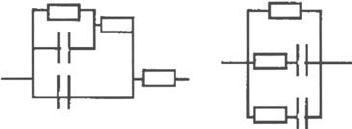
It is obvious that a drawback of this method is that the reaction should be
almost fully understood in order to produce a reliable transfer function. Another
drawback is the fact that for more complex reactions the number of variables is
very high. For a reliable fit the less important processes have to be ignored or
variables have to be fixed; in other words, the important parameters of the system
have to be estimated prior to the fitting procedure. In many cases the interpretation
of measurements on coatings will be extremely complex due to the unknown
geometries and local variation in electrolyte concentrations.
In this approach, one has to start with at least some idea of a physical
model of what is happening in the measured system. This physical model is then
transformed into an equivalent electrical circuit using only electrical components
such as resistors and capacitors and some special components representing transport
phenomena. An objection to this method is the fact that often more than one circuit is
possible and circuits might also be rewritten in a different configuration without
changing the response. This makes the interpretation in terms of chemical and
physical parameters difficult. Figure 13, for example, shows two different circuits that
give exactly the same response if the right values for resistors and capacitors are used.
Despite these objections, it is often possible to configure reasonable circuits that
can be fitted to the measured data. Especially for intact coatings, the dielectric
behavior and deviations from ideal behavior may give valuable information. Due to
the precision of the measurements, it is in many cases also possible to measure small
changes in coating properties that result from changes due to weathering, aging, etc.
Three examples of the use of EIS will be given next: atmospheric water
uptake, measurements during delamination of intact and perforated coatings, and
measurement of reproducible laser defects.
Atmospheric Water Uptake
The water uptake of organic coating can easily be monitored using the strong
dipole of the water molecule. Because of this dipole character, the dielectric constant
of water is high compared with that of most polymers [93]. Therefore a small
amount of water absorbed in an organic coating will give a strong change in the
dielectric constant of the system coating plus water. Dielectric constants can be
studied using impedance spectroscopy. In this situation the term “electrochemical
impedance spectroscopy” is not quite correct because no electrochemical but only
physical parameters are measured. It is, however, widely accepted to use the term
EIS instead of IS and for simplicity this terminology will be followed here too.
It is also interesting to follow water uptake under atmospheric conditions.
Because no bulk electrolyte is present in this situation, special arrangements have to
Organic Coatings 711
Figure 13 Two different equivalent circuits with the same impedance response.
Rectangles represent resistors, parallel segments capacitors.
Copyright © 2002 Marcel Dekker, Inc.
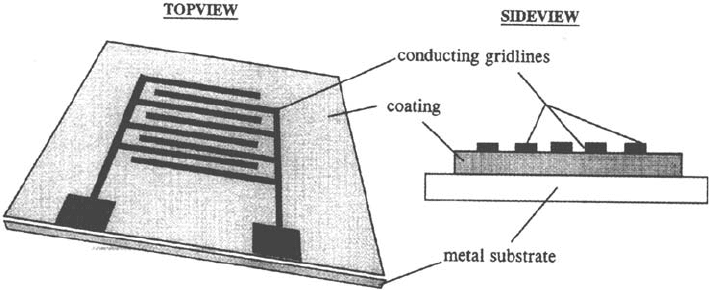
be made in order to make impedance measurements possible. This can, however,
easily be done with the setups presented next.
If grids of a conduction metal are applied by, for instance, PVD on top of the
coatings, an EIS measurement can be performed using either the two combs of the
grid as electrodes or the grid and the metal substrate as the electrodes. The grids may
also be placed underneath a coating if the substrate is not conductive. In the case of
multilayer coating systems they may be placed in between the different layers to
ensure the properties of the individual layers. A possible configuration for a grid is
given in Figure 14.
The geometry of the grids may of course differ from the one presented here.
Normally, measurements are performed between the metal substrate and both arms
of the grid. It is, however, also possible to measure between the two arms of the grid.
A disadvantage of this type of setup is the fact that an impermeable metal
coating covers part of the surface. This changes the transport route for water. Grids
arms should therefore be as thin as possible.
Grids can easily be produced on top of coatings by PVD. Often gold is used for
this purpose. If coatings are applied to inert and nonconductive substrates (e.g.,
glass) the grid can be placed underneath the coating and the higher precision of
lithographic techniques can be used produce finer grid lines.
Using these grids, a series of impedance measurements was performed on
panels coated with a clear two-components epoxy. The panels were put for at least
3 days in a furnace at 40°C to dry completely and after this period they were
exposed to an atmosphere with an RH of 20%. Starting from 20% RH, the humidity
was increased stepwise after some days of exposure. This stepwise increase was
repeated until in three steps an RH of 90% was obtained. Then the atmosphere
was brought back again in the same steps to 20% RH. During these periods
the impedance of the grids was measured continuously. The results of these
measurements are shown in Figures 15 and 16. In these figures the capacity values
as determined from impedance data are presented.
Both series of measurements in Figures 15 and 16 seem to give approximately
the same picture. The differences that are visible between the two cycyles are caused
by differences in exposure times in the different atmospheres. One big difference
712 de Wit et al.
Figure 14 A possible configuration for a grid used to study atmospheric water uptake [63].
Copyright © 2002 Marcel Dekker, Inc.
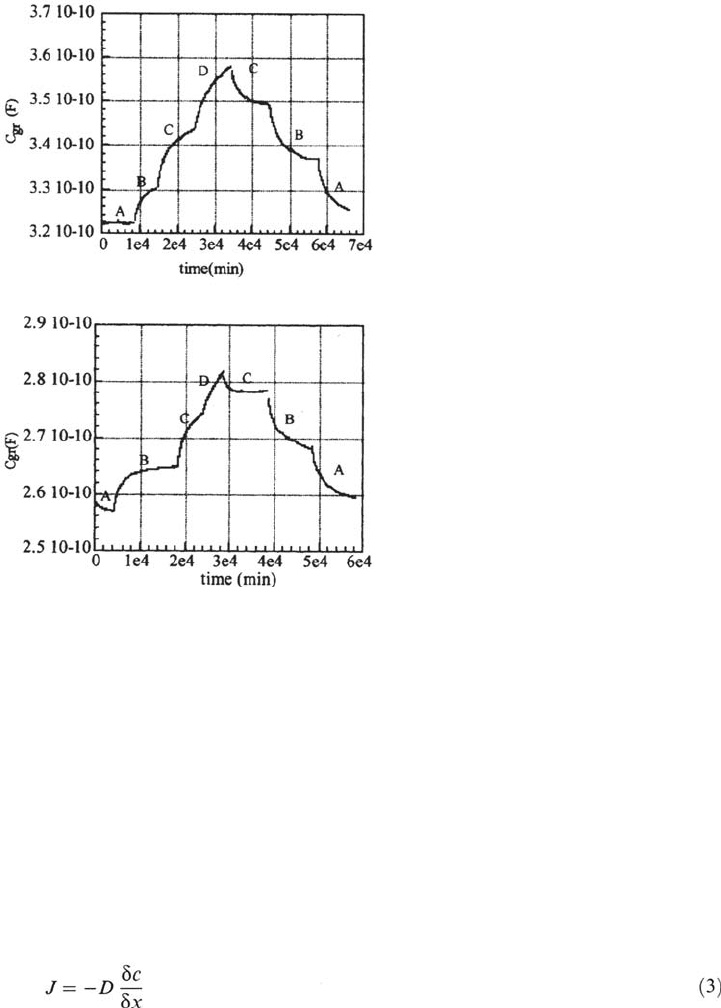
between the two series is, however, the absolute value of the capacitance. This is
caused by the different surface area of the two grids.
For the transport of water the diffusion coefficient is also an important factor.
The cyclic experiments can now be used to test whether D is independent of the
amount of water absorbed in a coating. This is normally assumed in studies of water
uptake by organic coatings. To describe the diffusion in a one-dimensional system,
Fick’s law is used:
Organic Coatings 713
Figures 15 and 16 Two examples of the capacitance (C
gr
) as determined from impedance
measurements performed on the grids as a function of time. A, B, C, and D refer to RH
values of 20, 60, 80, and 90%, respectively. Thickness of the coatings was 92 μm (left) and
98 μm (right). The cycle in Fig. 15 took about 7 weeks, and in Fig. 16 about 6 weeks.
Because all coatings in the cyclic experiments have a thickness (δx) of around 90 μm
and within the cycles the thickness is assumed to be constant (no swelling occurs), a
comparison of the diffusion coefficient of water in the cycles can be made. Because
of the constant thickness δx can be set to unity. Furthermore, the flux J is equal to the
increase in water content in time, which is approximately proportional to δC/δt
(C = capacitance), which is the derivative of the curves in Figures 15 and 16. Finally,
δc is the change in relative humidity going from one atmosphere to another.
Copyright © 2002 Marcel Dekker, Inc.
